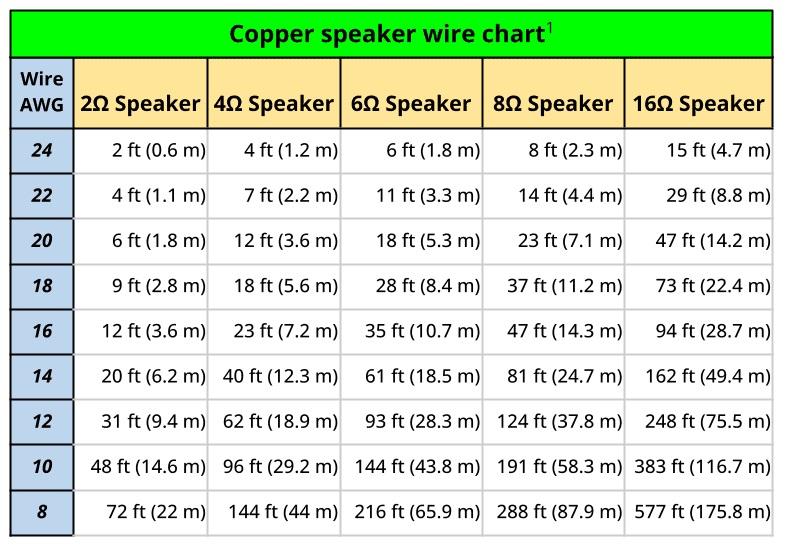When you go to the market to purchase speaker wire, you will find that they are available in different sizes. Besides, there are different materials of which these speaker wires could be made. In this article, we will cover all the different aspects of speaker wire and provide a detailed speaker wire gauge chart so that you can determine which one you need.
Understanding Speaker Wire Gauge
According to the American Wire Gauge (AWG) chart, a speaker wire comes with different gauge sizes. There are many specifications on which the gauge size is determined. The most preferred parameter is resistance per foot. Here are the speaker wire gauge charts showing wire size vs speaker impedance.
Basically, before purchasing, you have to know your speaker ohm rating and the distance the wire has to cover to connect the amplifier to the speakers. The longer the distance, the smaller should be the wire gauge.
Factors To Determine The Perfect Speaker Wire Gauge –
1. Speaker Impedance and Speaker Gauge Wire
Speakers that have lower impedance draw higher amps when compared to higher impedances speakers. When the amplifier is supplied to an audio signal, it can greatly impact your wire size requirement according to the power carried to the speakers and on the length. For higher amps, there has to be thick wire. Thick wire also has low resistance. This will give the advantage of having enhanced durability and there will be less power loss even at high power levels. Wires available today have two conductors and are the same stranded power cable. They can be in the range of 10 to 20 gauges and the most popular one is the 18-gauge. Occasionally, lower power speaker also uses thin wires with 20AWG or 22AWG.
2. Stranded and Solid Connectors
You must know that all speaker wires available are stranded. This means that it comprises 16 to 60 or even more fine copper conductors. On the contrary, a solid wire comprises a single conductor. Stranded wires use more conductor strands where one is larger than a smaller gauge. Standard wire also is not prone to break and offers better flexibility when compared to solid wire. Additionally, you can easily strip the insulation to the bare wire by just using a wire stripper. When you happen to insert it into a crimp connector or work with spade connectors, you will find fewer complications in a stranded wire. Never use leftover house electrical wire for the speakers as it can be a bad choice.
3. Copper-clad Aluminum and Copper Wire
With the price of copper shooting up, manufacturers have now focused more on copper-clad aluminum wires. Copper-clad aluminum wires have an aluminum wire core along with a thin copper plating. From the outside, the plating gives it a purr copper look. An advantage of aluminum is that it is more affordable than copper and is also very lightweight. This makes it a perfect replacement for a copper speaker wire. However, aluminum has 39% more resistance than the conductivity of copper and you will have to use larger aluminum wires for the same resistance value, power handling, and capacity.
How Much Wire You Need?
While buying speaker wire, you always want to buy in excess so that you don’t run out of it while working. However, it is always advisable to measure first and not overestimate what you require. It will be better if you use a long length of string or a tape measure. While measuring, you will have to take the bends and curves into account. You don’t have to worry if it is not exactly right. Even after measuring, you can add an extra foot or two for curves and other bends. Place it around the path where the wire will go. Mark the length correctly and again measure it.
Figuring It Out Properly –
Generally, speaker wires are available in rolls of 25, 50, and 100 feet. You may even find it loose and get the required length. Sometimes there are precut lengths which can be 6 feet, 12 feet, or 18 feet. When you happen to buy a good quality roll, you will be able to save money. A key piece of advice will be to buy a little bit more than what you are estimating. Here is an example to determine the wire length. For your home stereo, if the front speaker lengths are 2 x 6 feet and the rear speakers are 16 and 22 feet, then the total wire requirement will be 50 feet. In case you happen to use it for your car stereo, then you will be requiring rear speakers of 16 and 20 feet along with two front speakers of 8 feet each. This will be a total of 52 feet.
Choosing The Material –
If you happen to use speakers at high power levels, you much go for the one that has 100% pure copper wire. It may not be an issue if you use the speakers for average listening. When you happen to replace the copper wire with a CCA speaker wire, always move one gauge in size. The replacement of an 18-gauge wire will be 16 or 14AWG copper-clad aluminum wire. Comment * Name * Email * Website
Δ






![]()